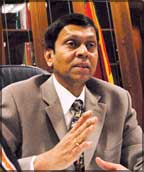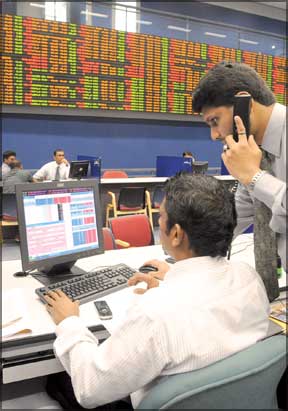Peak optimism drives economy forward
 A Western economist amazed at Sri Lanka’s economic resilience despite
a global slowdown remarked that policy makers were getting it right
almost flying by the seats of their pants. Even the most conservative
analysts concurred that the economy is on an upward driving spiral. A Western economist amazed at Sri Lanka’s economic resilience despite
a global slowdown remarked that policy makers were getting it right
almost flying by the seats of their pants. Even the most conservative
analysts concurred that the economy is on an upward driving spiral.
The IMF believed that increased economic activity and export growth
within a recovering global economy would boost the country’s economy.
Optimism is obvious.
For decades, the terror war had robbed Sri Lanka of the prosperity
its Asian neighbours enjoyed since the 1980s. There’s a lot to rebuild.
Sri Lankan policy makers planned for a gradual take-off. They knew that
there was no magic policy bullet, no easy panacea and smooth way out.
They just stuck to their job. Many believe that the international
financial meltdown did not blindside the Government as it continued to
develop the country with vigour.
|

Central Bank Governor Nivard Cabraal |
The Central Bank Governor Nivard Cabraal threw everything into
it-discount rate cut, loan programs, and investment-stimulation and
inflation inhibition. The formula worked like a charm.
He had a challenging task goaded on by the President trying to
maximize the development in the North and East. He liked it though as he
tried to balance an enhanced growth rate with a manageable budget
deficit in the current year.
The Central Bank seems capable of keeping the budget deficit to six
percent of gross domestic product in 2010 from an estimated seven
percent last year as recommended by the IMF, which approved a $2.6
billion loan to Sri Lanka the country last year. The IMF is likely to
grant Sri Lanka a third tranche of the loan of about $330 million after
a review of the island’s economy.
“We don’t want to get in the way of reconstruction, but the
underlying deficit path should be on a downward trend,” Director Koshy
Mathai, recently. “The budget deficit is always a risk, but so far the
Government has done well in meeting their targets.”
Asia’s best performing Share Index
The yield on the four-year government bonds held steady round 11.8
percent according to many bankers. The Sri Lankan rupee changed
little-hovering around 114.68 per dollar. The Colombo All-Share Index,
Asia’s best-performing gauge last year kept close to 3,775.
|

The busy stock market |
So far the Central bank has successfully maintained flexibility in
the foreign exchange rate and is capable of maintaining foreign reserves
covering up to 3 1/2 months of imports by having the reserves in a good
position. IMF has been supportive in helping Sri Lanka avert a
balance-of-payments emergency. It is learnt that the IMF agreement may
allow development spending in the country’s Northern regions to be
excluded from the budget deficit calculations.
Critical issue
The IMF loan had not become a critical issue as claimed by some
forecasters. The IMF would not demand any reduction of expenditure on
construction as there are other constraints available.
Peace has spurred economic growth and helped Sri Lanka to exceed its
target in building foreign-exchange reserves, Governor Cabraal firmly
believed. The current level of foreign reserves of $ 5.1 billion is at a
very favourable level.
The Central Bank has no immediate plans to further expand its foreign
reserves or raise interest rates, Cabraal said. The option to raise
borrowing costs is “open if inflation moves beyond a certain level,” he
added.
Cabraal has kept the Central Bank’s benchmark reverse repurchase rate
at a five-year low-around 9.75 percent since November-to help spur
growth to over six percent this year. That is the forecast now.
The Central Bank has also targeted average inflation of between five
percent and six percent by end-2010, Cabraal said. Consumer prices in
the capital, Colombo, rose to 6.5 percent in January from a year
earlier, the most in 11 months. That may not mean a sharp rise in
inflation during the rest of the year.
Tremendous money flow from outside
Sri Lanka is expected to keep the rupee “stable,” even though the
“tremendous money” flowing in from abroad is increasing pressure on the
currency to gain. Governor Cabraal believes that policy rates are at the
right place,” IMF’s Mathai said recently.
Banks have now got into the mode of supplying credit and it’s not
just to the consumer sector but also for investment and working capital.
The IMF seemed to think that there is less to worry about the buildup of
inflationary pressure.
When viewed macro-wise, the predicted growth forecast of 6.0+ percent
may stand the test of time due to improving domestic demand and
potential export growth after end of the 25-year terror war. If the
global environment were to improve a notch or two, Sri Lanka may even
see a higher investment climate.
Stability is easily discernible within the economy.
Sri Lanka’s monetary outlook is sound barring any unforeseen medium
term risks. The country has come out from a short term risk position
following a balance of payments crisis. But things have worked out in a
positive way. Koshy Mathai seemed to believe that both monetary policy
and fiscal policy were sound.
Country’s trade deficit began to contract as a result of low global
prices on commodities such as oil, and remittances began to recover
while foreign investors underwent a ‘dramatic change in sentiment.
Investments began to flow in and country’s equities and Government
securities were well received.
Credit to the private sector is picking up and from what the banks
are telling us these loans are for long-term projects and not for
consumption, so those are non-inflationary. There is cautious optimism
that the policy framework of Sri Lanka looked solid.
Annual inflation, which reached a record high of 28.2 percent in June
2008, slowed to a record low of 0.7 percent in September last year. It
is around six to seven percent now. Foreign currency reserves are now at
record high of over $5 billion. It augurs well for a steady growth
ahead. |



